As the distance between neighbors has gotten closer, blocking or reducing sound transfer in new or existing construction is more crucial than ever. So are you looking for soundproofing spray foam for existing walls? If so, it is necessary to learn some information before setting it up.
A major advantage of using soundproofing spray foam to minimize unwanted exterior noise in your home is how simple it is to install. It may be installed in existing walls without removing or harming the drywall. We have come up with a detailed guide below to help you understand it better. Dive in!
What is a Soundproofing Spray Foam?
Soundproofing spray foam, also called spray foam insulation or polyurethane foam, is an expanding foam mostly used for insulation and soundproofing.
Spray foam is a popular construction material used for wall thermal insulation in home construction, and it can be bought in most hardware, maintenance stores, and building supply centers.
Although its main purpose is to keep your home warmer during the winter and keep it cool during the summer, it's suitable for sealing gaps where noise and air could slip through. It works well to control noise because it creates an extra sound barrier between connecting walls, and it should be done correctly to avoid the expanding foam causing bulges.
How Does Spray Foam Work?
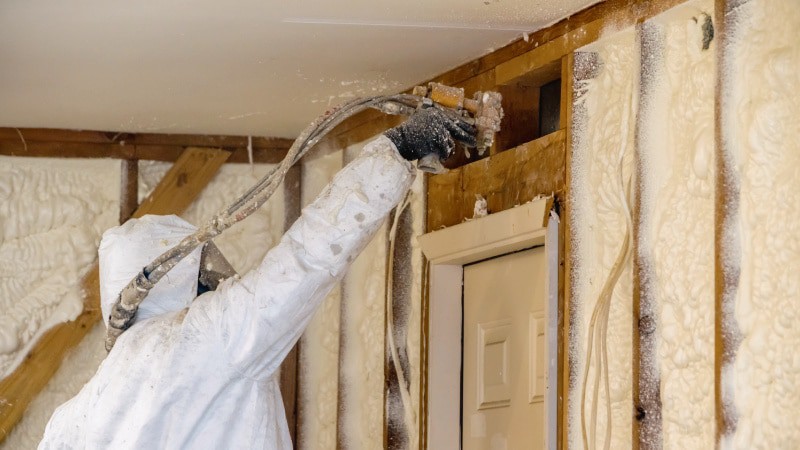
Image Credit: soundproofingtips.com
Soundproofing existing walls can be either cheap or costly depending on the level of acoustic insulation. However, you also need to take into account the size and shape of the room as big rooms will create a clear sign of echoes and reverb.
Spray foam is easy to apply and can be used in any desired environment. For example, it can be used on the existing wall and under the roofs since small holes are made and then the foam is injected into the holes.
It does an excellent job at soundproofing, and it also serves as an insulator, which means your home will be warmer, and you will save up to 50% on energy costs.
1. Loctite TITE FOAM Insulating Foam Sealant
- EXPANDS TO FILL: Loctite TITE FOAM Gaps & Cracks fills, seals,...
- SUPERIOR FLEXIBILITY: Withstands building and material movement...
- STRONG ADHESION: Sealant bonds to most building materials like...
- UV RESISTANCE: Withstands harsh UV rays for long lasting results
- STRAW APPLICATOR: For application simply use the attached straw...
Foam sealant by Loctite is among the most effective products for crack and gap sealing since the product expands to fill voids up to three inches in size. Furthermore, we found out that it could be used almost anywhere that there are other existing walls, even on baseboards, windows, doors, crawlspaces and even HVAC ductwork among others.
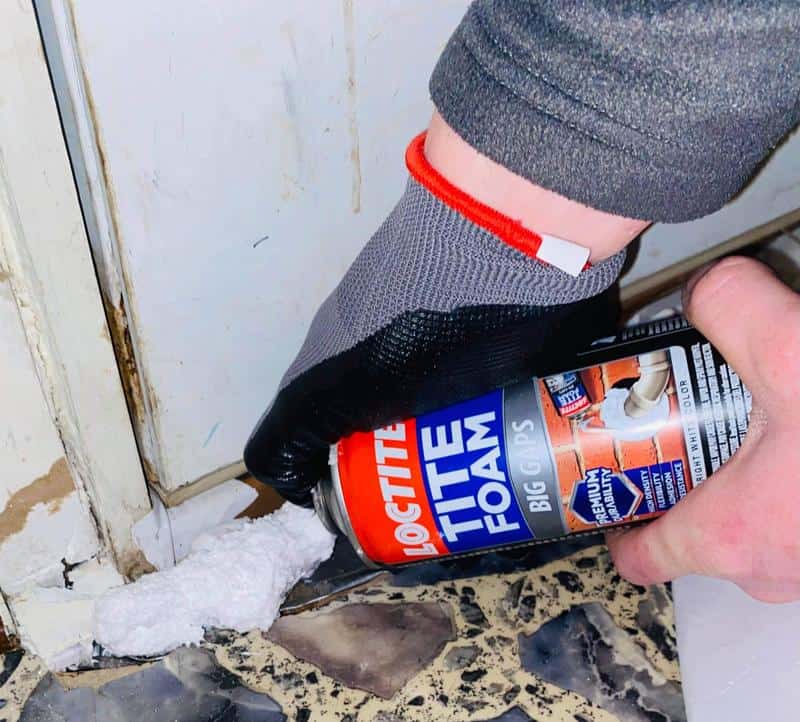
Image Credit: lowes.com
This kind of spray foam insulation has flexibility but high density; even though there is movement in building material, the seal will not be completely broken. Also, you do not have to worry of doors or windows bending following the application.
The Loctite foam sealant is a polyurethane based product that once applied foams to seal and fill gaps. Other people say that it is relatively simple and can be used again and again in various tasks. Last but not the least, this open-cell foam possesses a good adhesive property that makes it stick on to stone, wood, concrete as well as other materials.
Pros:
Cons:
2. Great Stuff 157911 Insulating Foam Sealant, 20 Ounce, Ivory
- Elegant design and Smooth finish
- Expanding foam sealant for insulation and air sealing
- 20-ounce can for easy application in various areas
- Ivory, blends well with most surfaces
- Great for both interior and exterior use
Great Stuff insulating foam is a great and cheap alternative to seal air gaps and cracks in your home if you need the top of the line spray foam insulation for existing doors, skylights, and windows. This foam sealant forms a neat and quick water tight seal wherever it is applied and is flexible, allowing it to be used on any surface.
This is a sound-deadening foam which can be used between a frame or other rough openings, and after installation you will discover that your doors, skylights and windows will be less susceptible to damage from the elements.
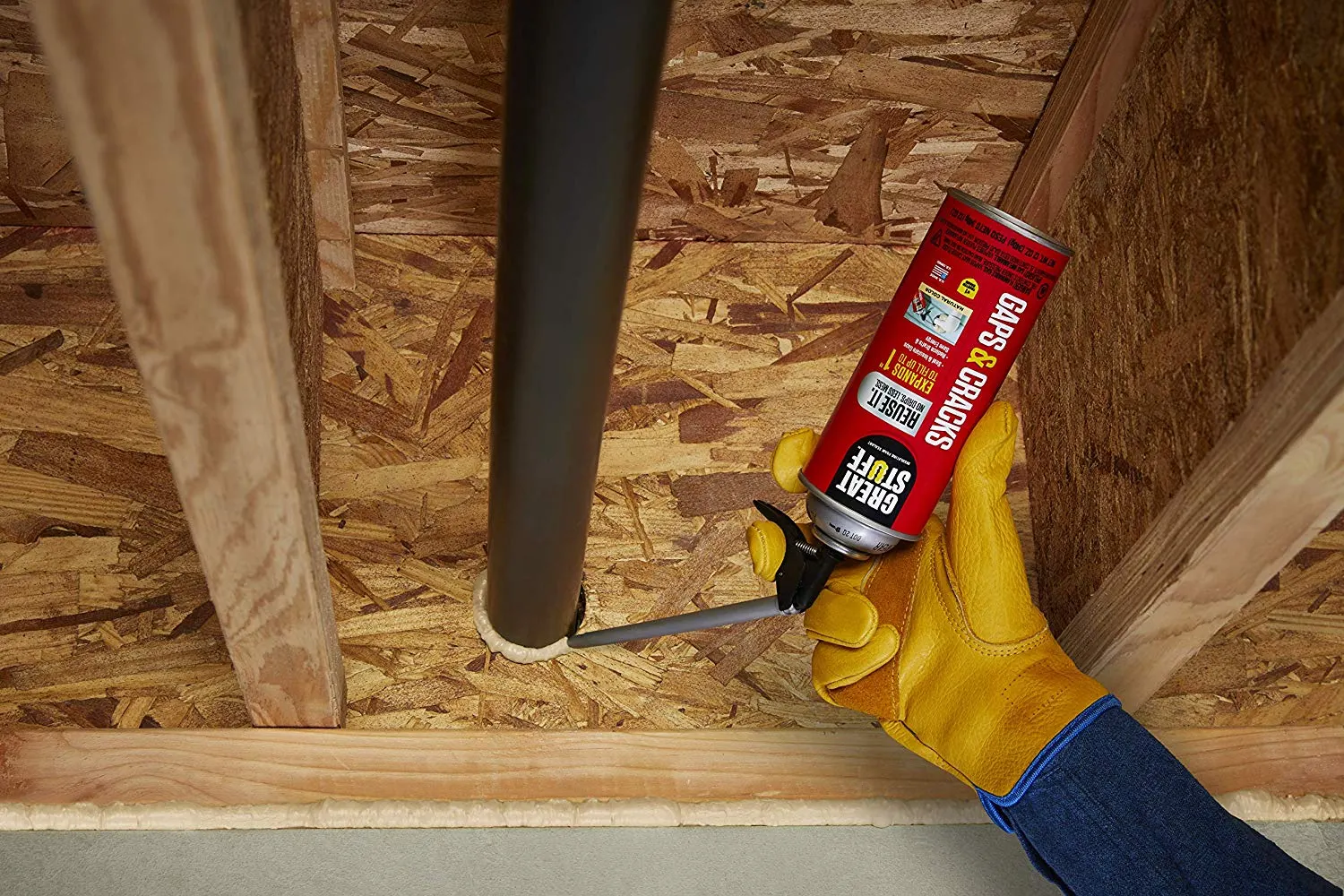
Image Credit: spy.com
Great Stuff soundproofing foam is a moisture-tight, water-resistant, and airtight closed-cell spray foam. It was designed to be pliable but not brittle once it has cured because it does not swell much with low pressure build.
Moreover, because the noise reduction spray is long lasting, we assure you that it will create a seal that can effectively prevent the drafts and air from coming through a door or window thus blocking some sounds.
Pros:
Cons:
What are the Types of Soundproofing Spray Foam?
The two types of spray foam insulation are both made of two components that when sprayed into cavities or walls they expand before they set.
Open cell spray foam is quite vulnerable and can be easily compressed, and, therefore, the product also has a lower R-value. However, closed cell foam insulation is a rigid one because every single cell of air is closed. Consequently, it has a high R-value but is costly compared to the open-cell spray foam.
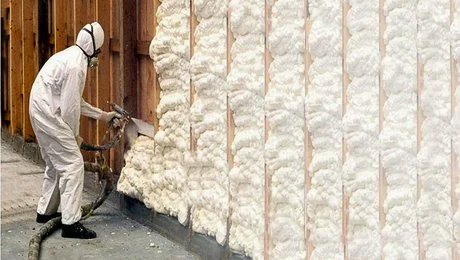
Image Credit: reddit.com
a). Open-Cell Spray Foam
Open cell foam is also known as half pound foam and is semi rigid and has the appearance of a sponge. It develops during the application and forms small open cells that contain carbon dioxide.
Open cell spray foam is the exact opposite of closed cell foam since it is light weight and can expand as much as three inches. This type is ideal for use in crack, crevice, and void areas to bond well with irregular surfaces and substrates to form a tight sealing insulation.
It is ideal for general sound insulation because of its depth and is cheaper compared to the closed cell foam insulation material. Hence, if you are to use open cell foam in your home for adsorption of noise or enhancing insulation then ensure that the one you are to buy has high performance as indicated above.
b). Closed-Cell Spray Foam
Closed cell foam is rigid, heavy, and dense. This one is made of polyurethane with closed cell structure. Closed cell foam has a relative porosity which is not very high to allow the entry of little air and heat. It is waterproof and assist in preventing moisture buildup on surfaces in your room’s interior.
Closed cell foam, especially the compact type, has limited cell structure expansion, about an inch. This is important because it assist in the creation of dense and firm foam quality to enhance wall construction and seal cracks.
How to Use Noise Control Spray Foam on Existing Walls?
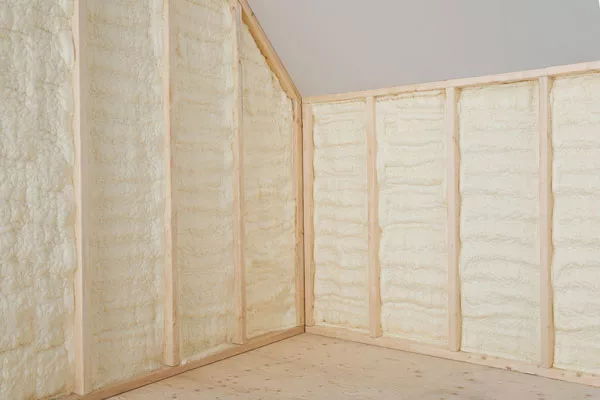
Image Credit: greatstuff.dupont.com
There are three successful yet economical ways to use soundproofing control spray on existing walls, and they include:
1. Sealing Wall Cracks and Crevices
Your walls' gaps and crevices can let in about 50 percent of the usual noise. You can also have a more serene home atmosphere by using quality spray foam to close up these vulnerable areas and gaps.
You can add more soundproofing materials if you want once the foam expands, takes all the gaps and dries up. The materials may comprise of soundproofing paint, acoustic foam panels and wallpapered walls.
To enhance the absorption of interior room noise, it is possible to use it in conjunction with acoustic foam panels. Therefore, when you reduce the noise levels of interior and exterior sounds you will enhance the quality of your rooms for sleeping, reading, conversation or studying.
2. Apply Spray Foam between Drywall
Using the sound-deadening spray foam between the drywall, helps in reducing noise vibrations coming through exterior walls. Moreover the sprayed foam between the walls will help in reducing the sound wave pressure because the sound cannot reflect off the walls thus making your room more comfortable.
However, make sure you use open-cell foam spray for the best filling and sealing of holes that allow the sound from the outer environment to penetrate your room’s interior. First timers in home soundproofing may not enjoy using spray foam because it is time consuming and messy.
Over time, you will start to see and appreciate it as a valuable investment as a soundproofing strategy in your home.
3. Use Foam Spray around Acoustic Panels
If you are applying the acoustic spray foam panels on the wall you should attempt to spray foam around the edges of every panel that is to be installed separately. If you are using these sets of panels to work on a large area of a wall, it helps to spray around the whole set of panels.
This will seal any gaps, cracks or holes and that will in turn lessen or stop the sound from getting into your residence.
However you can seal the cracks and gaps with spray foam insulation and then put the acoustic panels and you have to wait for the spray foam to dry first before putting the acoustic panels.
Foam noise reduction spray foam is versatile because when used in combination with sound suppression paint, it is possible to achieve the best results.
How to Maximize the Noise Reduction Results from Soundproofing Spray Foam in Existing Walls?
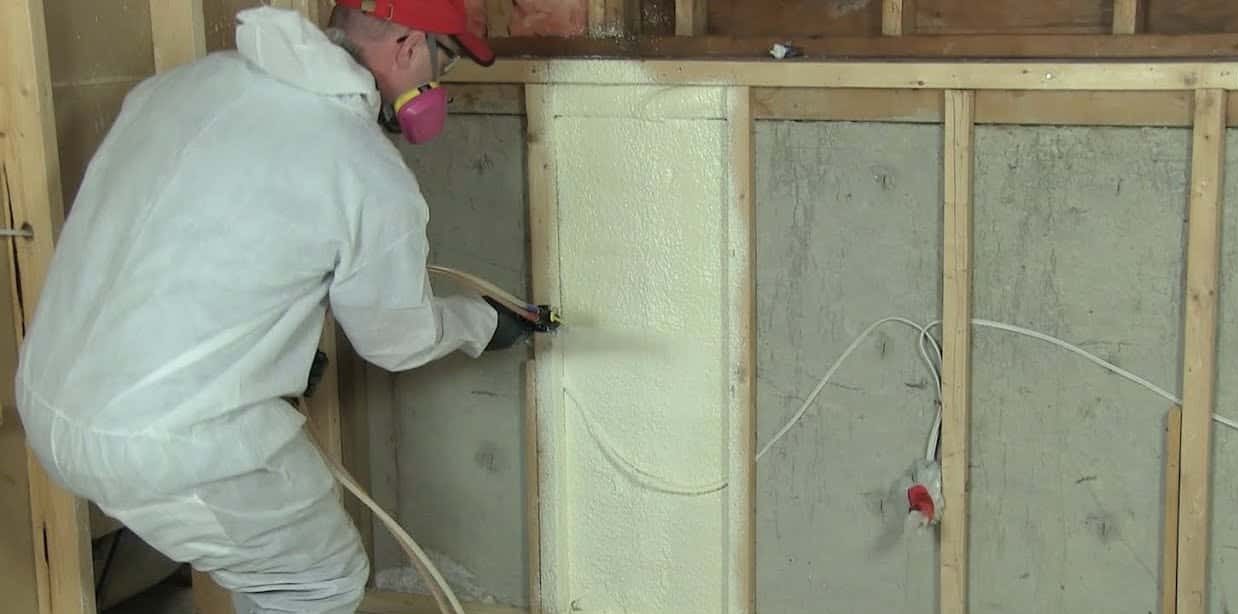
Image Credit: HouseImprovements
Walls are made of hard materials which means that any noise as well as any vibration can get through the walls. In more specific terms, it is quite easy to get the quality soundproofing when using spongy, soft and pliable materials. It is made of flexible soft and absorbent polyurethane which are used to make panels for noise dampening to reduce echo and initial noises.
Soundproofing spray foam is an excellent product for sound deadening but for a proper and more effective seal it is recommended to use it with other sound suppression techniques. The foam spray is suitable for complementing and improving the performance of other methods to achieve the desired results of sound wave reduction and quality absorption.
How is Spray Foam Insulation Beneficial?
- Excellent soundproofing hence you cannot be easily disturbed by noises from the outside world.
- Better health and quality of life since it’s made of water which makes it friendly to use in your home.
- Convenient to install because you do not have to bring down walls to get them in place.
- Cheaper Energy Bills because the foam helps the house to feel comfortable in extreme temperatures thus you spend less on energy bills.
- Suitable for thermal insulation, effective spray foam.
- This part offers a barrier against moisture and air.
- As useful as the foam can be applied to walls, wall voids, ceiling, and gaps.
What are the Disadvantages of Spray Foam Insulation?
- Has a very low sound insulation feature.
- Improves the feedback, reflective resonance and sound distortion.
- It is chaotic, and, thus, could negatively impact one’s health.
- Most of these surfaces are known to have very poor or no sound absorption properties at all.
- It can be expensive.
What are Spray Foam Sound Ratings?
To understand the Acoustic Spray Foam sound ratings there are certain things that you need to know when you come to measure the sound intensity. This is useful in a way that it enables one to get the right decisions concerning his or her needs.
There are two important measurements of sounds; hertz measure sound frequency and decibels measure the intensity of sounds. However, with the exception of decibels and hertz, you will need to measure NRC (Noise Reduction Coefficient) and STC (Sound Transmission Class).
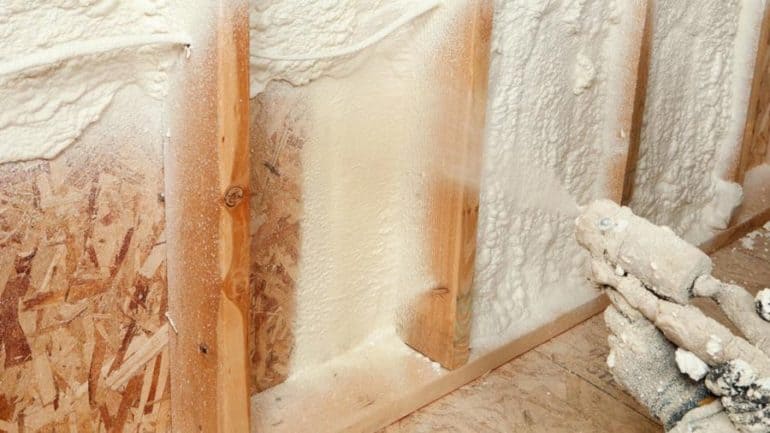
Image Credit: soundproofanything.com
Sound transmission class is a measure of how much a component or material reduces or hinders the passage of sound waves. The higher the STC rating, the more amount of noise will be blocked from passing through this, which is a great sign that you are getting a good quality sound insulation material.
However, the noise reduction coefficient measures how much a material reflects or absorbs sound waves. The better the soundproofing properties, the greater the number, measured in hertz.
Once it is applied, an open cell soundproofing foam expands to three inches and has an STC of up to 39 and an NRC of 0.70. However, closed cell spray foam expands only one inch when applied with an STC of 36 and an NRC of 0.70.
Conclusion
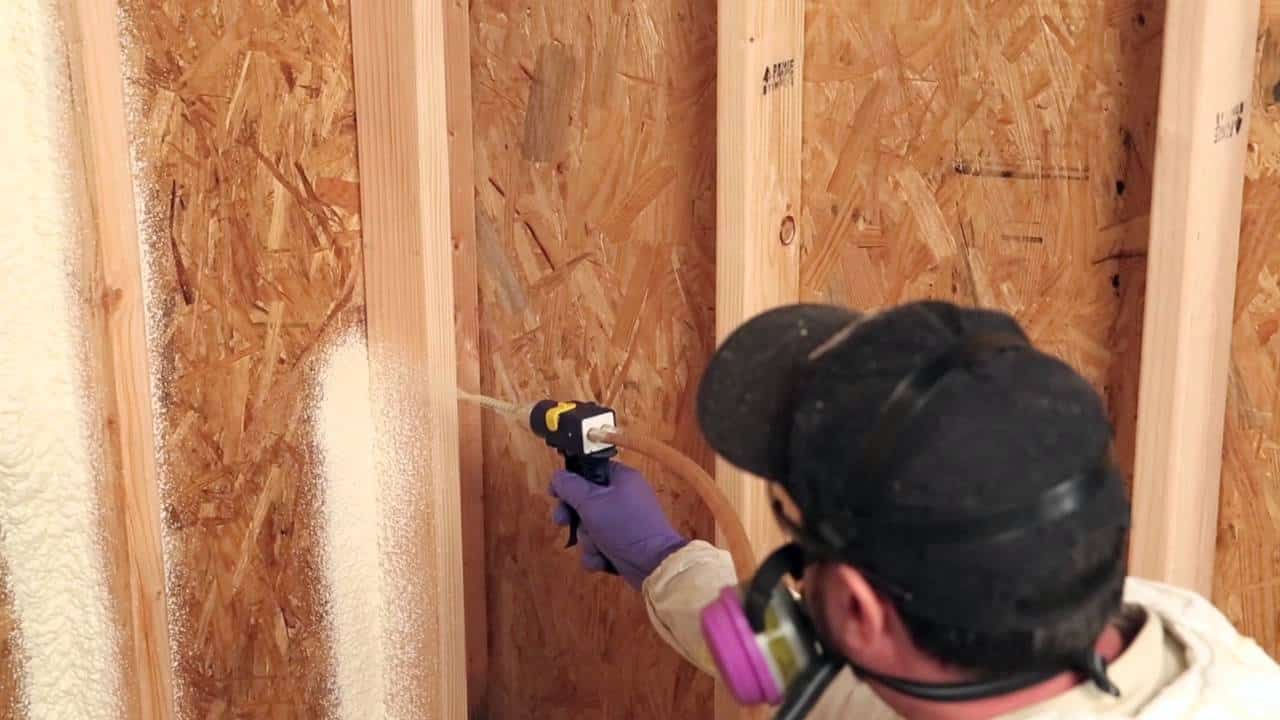
Image Credit: touch and seal
Although soundproofing spray foam for existing walls is not the most effective way to soundproof against exterior noise, it dampens the sounds that may be coming through the walls of your home. However, the combination of this with other noise reducing and sound insulation materials can be seen as a good base to work with.
This method gives a sturdy seal at the edges of acoustic foam panels to enhance the sound proofing mechanism. Besides, they are used with soundproofing paint, which means that this noise reduction plan will also be effective in the future.
Frequently Asked Questions Soundproofing Spray Foams
1. Is there a Difference Between Sound Deadening and Soundproofing?
Soundproofing a room means that no noise is heard from the outside, and no noise from the outside can be heard from within the room through the floor, walls or ceiling. But sound insulation hides how much sound comes into your room. An injection foam in your walls will make the sound transmission to be reduced by about 80%.
2. What are Other Ways of Soundproofing Existing Walls with Insulation?
If you are looking for other methods of soundproofing walls, there are several options to check out, and they include:
- Soundproofing curtains
- Mineral Wool
- Soundproofing paint
- Batt Fiberglass Insulation
- Fiberglass Insulation
- Soundproofing panels
- Dense Packed Cellulose
- Mass loaded vinyl
- QuietRock Sheetrock
3. Does the spray foam insulation work well for Soundproofing?
Most exterior walls are constructed in a superior manner to limit sound transmission and to provide insulation and interior walls are left with a hollow construction. Whilst spray foam insulation can do the job, it is not as efficient.
Despite the fact that open-cell foams have higher sound absorption coefficient than closed-cell spray foams, the latter cannot isolates the wall layers. Spray foam can stick to two wall layers and that opens up more paths for sound to travel through and bumps the noise transmission and resonance.
Image Credit: weekendbuilds.com














